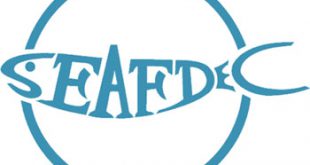Many farmers find it difficult to reduce the high degree of cannibalism in the nursery phase of mud crab (Scylla serrata) culture. Some of their strategies include size grading, reduction of stocking density, and provision of sufficient shelter. Though these mostly work, crabs are still vulnerable when they just molted or have soft shells. The solution?
“Trim the chelipeds during intermolt and postmolt,” suggested AQD scientists Dr. Emilia Quinitio and Dr. Fe Dolores Estepa, “and the cannibalism of crabs is reduced and growth & survival of clawless crab juveniles are improved in the nursery. Chelipeds grow back or regenerate, and crab farmers harvest whole crabs later on.”
Chelipeds are the jointed “claws” of mud crabs. These can be trimmed or cut using scissors. The only disadvantage is that trimming chelipeds is a tedious process.
The study, published in the science journal Aquaculture (Vol. 318, 2011), also noted that with trimmed chelipeds, community-raised S. serrata juveniles may no longer need shelters (which add to farmer’s cost) as long as there is enough food.
The above is just one of the studies conducted and published by AQD on mud crab. The most recent 2010-2011 publications include:
Laranja JLQ Jr, Quinitio ET, Catacutan MR, Coloso RM. 2010. Effects of dietary L-tryptophan on the agonistic behavior, growth and survival of juvenile mud crab Scylla serrata. Aquaculture 310: 84-90
Parkes L, Quinitio E, Le Vay L. 2011. Phenotypic differences between hatchery-reared and wild mud crabs, Scylla serrata, and the effects of conditioning. Aquaculture International 19:361-380
Primavera JH, Binas JB, Samonte-Tan GPB, Lebata MJJ, Alava VR, Walton M, Le Vay L. 2010. Mud crab pen culture: replacement of fish feed requirement and impacts on mangrove community structure. Aquaculture Research 41: 1211-1220
Quinitio ET, de la Cruz JJ, Eguia MRR, Parado-Estepa FD, Pates G, Lavilla-Pitogo CR. 2011. Domestication of the mud crab Scylla serrata. Aquaculture International 19 (Special Issue):237-250
Quinitio ET, Estepa FDP. 2011. Survival and growth of mud crab, Scylla serrata, juveniles subjected to removal or trimming of chelipeds. Aquaculture 318:229-234.

 SEAFDEC/AQD Southeast Asian Fisheries Development Center | Aquaculture Department
SEAFDEC/AQD Southeast Asian Fisheries Development Center | Aquaculture Department
